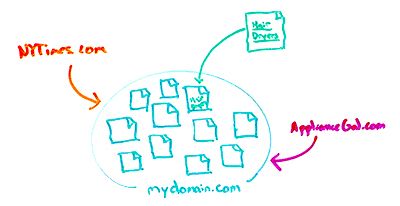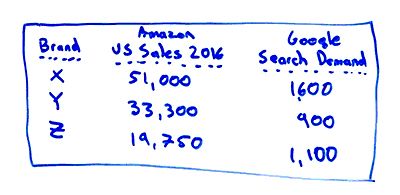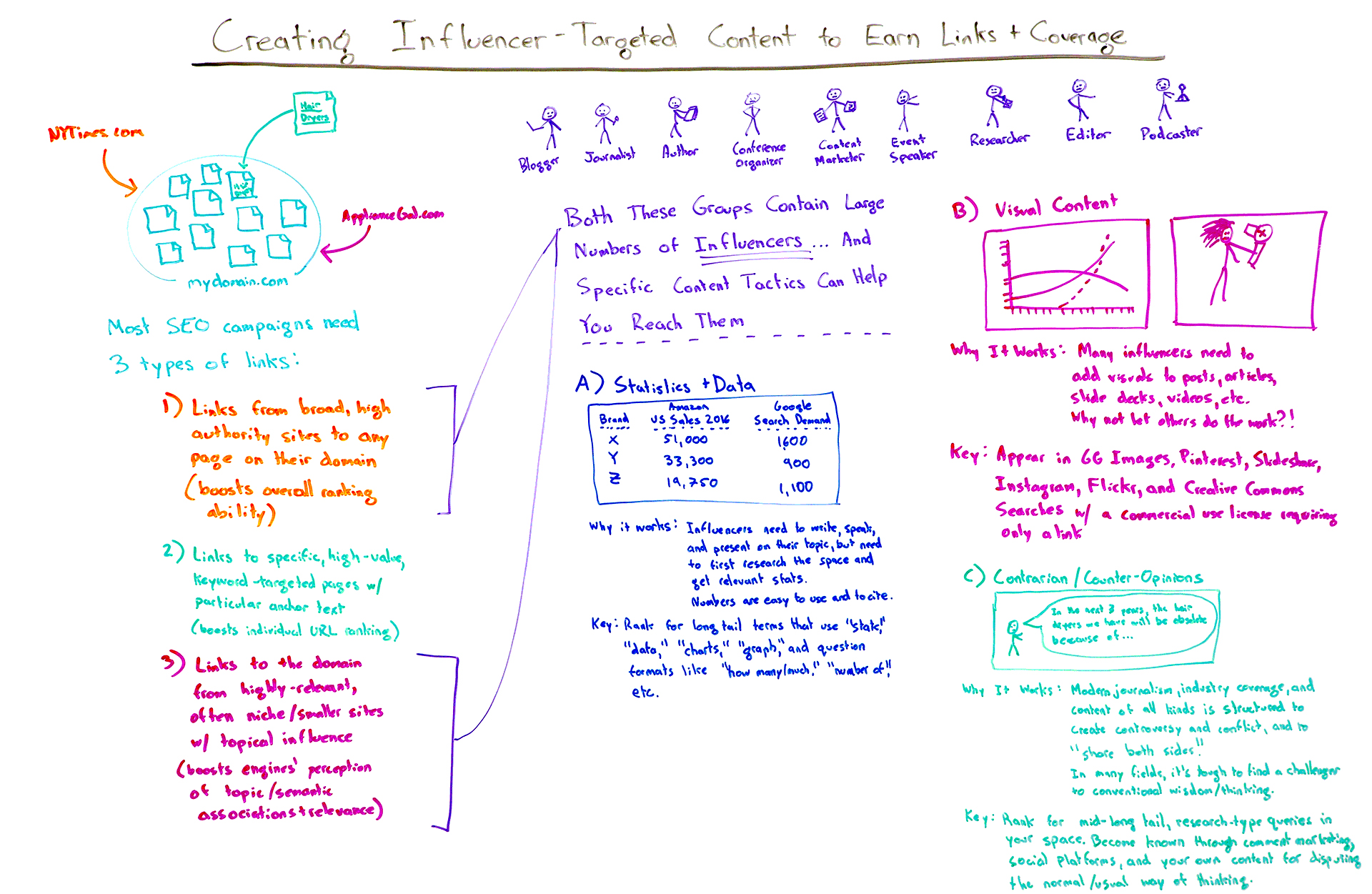Most SEO campaigns need three kinds of links to be successful; targeting your content to influencers can get you 2/3 of the way there. In this Whiteboard Friday, Rand covers the tactics that will help your content get seen and shared by those with a wide and relevant audience.
Click on the whiteboard image above to open a high-resolution version in a new tab!
Video Transcription
Howdy, Moz fans, and welcome to another edition of Whiteboard Friday. This week we're going to chat about how to create content that is specifically influencer-targeted in order to earn the links and attention and amplification that you often need.

Most SEO campaigns need 3 types of links:
So it's the case that most SEO campaigns, as they're trying to earn the rankings that they're seeking, are trying to do a few things. You're trying to grow your overall Domain Authority. You're trying to get some specific keyword terms and phrases ranking on your site for those terms and phrases.
So you need kind of three kinds of links. This is most campaigns.
1. Links from broad, high-Domain Authority sites that are pointing — you kind of don't care — anywhere on your site, the home page, internal pages, to your blog, to your news section. It's totally fine. So a common one that we use here would be like the New York Times. I want the New York Times to link to me so that I have the authority and influence of a link from that domain and, hopefully, lots of domains like them, very high-Domain Authority domains.
2. Links to specific high-value keyword-targeted pages, hopefully, hopefully with specific anchor text, and that's going to help me boost those individual URLs' rankings. So I want this page over here to link to me and say "hairdryers," to my page that is keyword targeted for the word "hairdryers." Fingers crossed.
3. Links to my domain from other sites, in my sector or niche, that provide some of that topical authority and influence to help tell Google and the other search engines that this is what my site is about, that I belong in this sphere of influence, that I'm semantically and topically related to words and phrases like this. So I want appliancegal.com to link to my site if I'm trying to rank in the world of hairdryers and other kinds of appliances.

So of these, for one and three, we won't talk about two today, but for one and three, much of the time the people that you're trying to target are what we call in the industry influencers, and these influencers are going to be lots of people. I've illustrated them all here — mostly looking sideways at each other, not exactly sure why that is — but bloggers, and journalists, and authors, and conference organizers, and content marketers, and event speakers, and researchers, and editors, and podcasters, and influencers of a wide, wide variety. We could fill up the whole board with the types of people who are in the influencer world or have that title specifically, but they tend to share a few things in common. They are trying to produce content of one kind or another. They're not dissimilar from us. They're trying to produce things on the web, and when they do, they need certain elements to help fill in the gap. When they're looking for those gap-filling elements, that is your opportunity to earn these kinds of links.
Content tactics
So a few tactics for that. First off, one of the most powerful ones, and we've talked about this a little bit here on Whiteboard Friday, but probably not in depth, is...

A. Statistics and data. The reason that this is such a powerful tool is because when you create data, especially if it's either uniquely gathered by you, unique because you have it, because you can collect it and no one else can, or unique because you've put it together from many disparate sources, you're the editorial curator of that data and statistics, everyone like this needs those types of statistics and data to support or challenge their arguments or their assertions or their coverage of the industry, whatever it is.
- Why this works: This works well because this fills that gap. This gives them the relevant stats that they're looking for. Because numbers are easy to use and easy to cite, and you can say, "Feel free to link to this. You're welcome to copy this graph. You're welcome to embed this chart." All those kinds of things. That can make it even easier, but much of the time, just by having these statistics, you can do it.
- The key is that you have to be visible at the time that these people are looking for them, and that means usually ranking for very hard to discover, through at least normal keyword research, long-tail types of terms that use words like "stats," "data," "charts," "graphs," and kind of these question formats like when, how much, how many, number of, etc.
It's tough because you will not see many of those in your keyword research, because there's a relatively few number of these people searching in any given month for this type of gap-filling data, so you have to intuit often what you should title those things. Put yourself in these people's shoes and start Googling around for "What would I need if I had to write some industry coverage around this?" Then you'll come up with these types of things, and you can try modifying your keyword research queries or doing some Google Suggest stuff with these words and phrases.

B. Visual content. Visual content is exceptionally valuable in this case because, again, it fills a gap that many of these folks have. When you are a content marketer, or when you're a speaker at an event, or when you're an author or a blogger, you need visual content that will help catch the eye, that will break up the writing that you've done, and it's often much easier to get someone else's visual content and simply cite your source and link to it than it is to create visual content of your own. These people often don't have the resources to create their own visual content.
- Why this works: So, for everyone who's doing posts, and articles, and slide decks, and even videos, they say, "Why not let someone else do the work," and you can be that someone else and fill these gaps.
- Key: To do this well, you're going to want to appear in a bunch of visual content search mediums that these folks are going to use. Those are places like...
- Google Images most obviously, but also
- SlideShare, meaning take your visuals, put them up in some sort of slide format, give some context to them and upload them to SlideShare. The nice thing about SlideShare, SlideShare actually reproduces each individual slide as a visual, and then Google Images can search those, and so you'll often see SlideShare's results inside Google Images. So this can be a great end around for that.
- Instagram search, many folks are using that especially if you're doing photos. You can see I've illustrated my own hair drying technique right here. This is clearly Rand. Look at me. I've got more hair than I know what to do with.
- Flickr, still being used by many searchers, particularly because it has a Creative Commons search license, and that should bring up using a Creative Commons commercial use license that requires attribution with a link is your best bet for all of these platforms. It will mean you can get on lots of other Creative Commons visual and photography search engines, which can expose you to more of these types of people as they're doing their searches.

C. Contrarian/counter-opinions. The last one I'll cover here is contrarian or counter-opinions to the prevailing wisdom. So you might have an opinion like, "In the next three years, hairdryers will be completely obsolete because of X."
- Why it works: This works well because modern journalism has this idea and modern content, in fact, has this idea that they are supposed to create conflict and that they should cover both sides of an issue. In many industry specific sorts of fields, it's often the case that that is a gap that goes unfilled. By being that sort of challenger to conventional wisdom or conventional thinking, you can fill that gap.
- The key here is you want to either rank in Google search engine for some of those mid or long tail research type queries. These can be competitive, and so this is challenging, but presenting contrarian opinions is often great link bait. This is kind of a good way to earn links of all kinds in here.
- Second, I would also urge you to do a little bit of comment marketing and some social media platforms, because what you want to start is to build a brand where you are known for having this contrarian opinion on this conventional topic in your space so that people point all these influencers to you when they're asked about it. You're trying to build up this branding of, "Well, I don't agree with the conventional wisdom around hairdryers." Hairdryers might be a tough topic for that one, but certainly these other two can work real well.
So using these tactics, I hope that you can go reach out and fill some gaps for these influencers and, as a result, earning two of the three exact kind of links that you need in order to rank well in the search results.
And we'll see you again next week for another edition of Whiteboard Friday. Take care.



Thanks for checking out Whiteboard Friday this week all. Some discussion questions I'd love your input on:
For me, outside of the three in the video, I'm also a big fan of content that's creates enemies (and thus, also creates allies)--more about that in a future WB Friday.
As far as tools and search methodologies go, I've actually been frustrated with the power of Instagram influencers but the lack of any tools to help ID them. Thus, I've taken to using search queries in Google formulated like this: tech blogger "k followers" site:www.instagram.com/ -inurl:/p/ (it may look odd, but basically I'm using the "k followers" to find only accounts with 1k+ followers, then using the site commands to get only accounts, not individual posts)
Look forward to your thoughts.
We've been known to slightly modify the 'get a link from a site linking to a competitor by pointing out your better content' tactic. Something along the lines of 'you've got some great content in topic x and topic y, and if you're looking to cover topic z, we've got exhibits a, b & c' - also playing a bit on the pre-emptive thinking you mentioned in the video.
I'm really looking forward hearing more about the 'content that creates enemies and allies' in your next WBF.
Thanks Rand - great to focus on for who and why we are producing content. In my experience, visuals created from stats have increased engagement especially. I think the key is to target individuals and research what information they are interested in - Linkedin groups & Quora can be helpful for this - otherwise following journalists on Twitter can give an idea of the subject matter they are interested in and the angle they take on things (and an opportunity to engage with them sometimes). The emphasis on long tail keywords and niche subject matter has worked better than being too generalised.
I've found a good way of getting your content in front of influencers is by using the search bios on Followerwonk. Type in a key term that your article is about and you can see the most prolific tweeters based on that topic. You can then tweet them with your content saying you thought they may appreciate it. I've found this increases the shareability of the content and its a good way of getting your content in front of industry relevant influencers.
+1! Followerwonk is definitely a good tool for this.
Just checked out Followerwonk and it's exactly what I needed. Thanks!
Hey Rand! Great video. Something else we've had a good amount of success with is "egobaiting" influencers, i.e. reaching out to a series of influencers and asking for a quote or anecdote about their field of expertise. We compile those quotes into a single list or infographic and then encourage the influencers to link to and share the piece to boost their own authority. This can be a good tactic especially for blogger influencers, it generally gets not only links but also social shares.
I love and hate what you shared here. "Egobaiting" - it works. We all know what this looks like and how it almost always ends up being a piece with little value except to the publisher (links, traffic, etc.) and maybe giving the influencer something to add to their LinkedIn profile.
Would love to see this concept/tactic applied in a way that added something meaningful and even spurred conversations (online even - imagine the links from that!).
I really prefer higher-quality interviews (e.g. https://www.groovehq.com/blog/rand-fishkin-moz-int... might have been egobait, but it was done so well, with such great questions and thoughtful curation, that I shared the heck out of it and have linked to it in several places) vs. the really basic and obvious egobait that doesn't provide value.
I did a WB Friday on some alternatives to roundups that might also include some decent options: https://moz.com/blog/better-alternatives-expert-ro...
Hi Sheena,
I guess technically you could say the most recent tactic I used for my most recent blog posts, which actually features Rand ;) falls under "egobaiting", but really, my goal was to feature top experts' expertise and thoughts for local business owners and marketers handling their marketing so they can start getting some traction with marketing for their business.
I enjoy interview-type blog posts and I think if you can feature people who are great at their stuff that people want to hear from and have credibility - everyone wins. The interviewees, who typically have a large & established audience, will want to share it. Your audience that its targeted for will want to share it with their audience if they found it extremely useful, etc. It also helps build up your authority in your space.
I haven't done a ton of link building, but I have found that my first blog post like this received some decent traction and I'd love to see where I can take things trying it again and with some of the tips Rand has laid out in this WBF.
Totally support this tactic! But I would NOT consider your effort "egobaiting" -- sounds like you put some solid word in to create something really valuable to your audience of small biz owners (I'll have to check it out!). What's key, as you shared, is that the goal was not link building. The links were a bonus for creating something awesome. :)
Hey Rand,
And thanks for another great WBF! I have tried this approach for a year now with the hope of getting wikipedia-links to my clients site - but so far no luck.
Do you have any experience working towards getting reference-links from wikipedia-articles towards content with well-documented and well-argued statistics?
I love this approach, but also see a bit of a chicken or the egg situation - rank so they find you and use your content so you can earn links and rank.
Instead of focusing on the links opportunity, I’m having more and more conversations about why we need to commit to creating something uniquely valuable (as you shared, research-based data is great!), then give it away as a contribution to your industry (which can quickly positions you as an authority) - and then lean on PR and existing relationships to get it in front of influencers.
I think this is an area many SEOs struggle - creating the content, then getting all tactical with the various tools we have for tracking down people who might care about this thing. I find this works much better: Get to know your industry's influencers, then create.
Also, a thought about the creative commons link attribution idea... love the idea. But it also makes me think of my fave image source (when I don't shoot it myself), Unsplash.com. They would crush it even more if they required something like this, but the fact that they don't is partly why I, and many others, love them so much.
Solid WBF!
Yes! Good point. Sorry if that wasn't clear. My intention was to say "rank for stuff that's easier to rank for, but which journalists/bloggers/influencers search for." One great way to do this, for example, is to leverage an already powerful domain that can rank well, e.g. Quora or LinkedIn or Inc (all of which are relatively easy to contribute content to), targeting queries that include things like "xyz stats" or "trend of xyz" or "examples of xyz." Those pieces could then serve to get you contacted, which can in turn lead to links.
Very good reflection Rand. I have a question regarding Shlideshare sharing. I have done it many times and then I link that content in an article on my blog. It's very cool.
My question is, if on those slides I add links to other web. Do these links transfer quality in DA and PA (SEO)?
Nice topic, Rand! It's trending and the most important factor to acquire high quality links like you've mentioned.
Also, I am struggling hard with this.
But, one quick question, how to keep a constant eye on what topic, the influencers, editors, journalists would be looking for in a specific month?
We can definitely read their articles regularly and most of the websites hardly have their calendar open for all. So, how to be at the right place at the right moment?
Thank You Rands! I really enjoyed the article. That reminds me I need to do some more linking. lol. I just do relevant links to my website. I'm just picky like that. Anybody else do this?
Hello Rand. Thank you for the great "whiteboard". :)
There are some people out there and use the content that others create without linking to them or adding any credentials. I'm afraid until these people don't change their ways, these methods hardly work.
Much appreciated,
You idea about the anchor text hairdryers, is a good idea, but I prefer to create anchor text with keywords long tail. Although there will surely be fewer searches, there will also be less competition and from there you can find a flow of users who visit our website.
About upload photos to Flickr pinterest, google images is also a good idea. Requires attribution with a link to the author it's a good way for create linkbuilding.
Great WBF Rand! It is never easy to make user influence, but continue contribution make impact.
I personally work with on tier 2 to tier 4 back-linking and have received proven results; these day I am even contribution to Wikipedia article
Also would like to thanks "Kuldeep Sharma" for tool that he has suggested!
Cheers
Thank you for the great post Rand!
Another great Whiteboard video, Rand. Thank you... but if i get approached on Instagram by one more person asking me to be a brand ambassador for their gym-wear, i'm going to wave fist and do a big frown in your general direction :D
Thanks for the Creative Commons idea though - that fits perfectly with one site that I'm working on at the moment.
Have a great weekend!
Love the pointer about three types of links. That is going into the vault. I think striving for photo rich, "clip-able" content is a great way to get links to your page from people in your niche. Having the best "Rand using hairdryer" picture is great. People might link it into their site. You can also have the best "Rand using hairdryer" graphic that people will want to use and re-use.
Thanks WBF.. It's a really helpful information. Here you can easy way to describe about need 3 types of links,it's right.. These 3 types of links through get the ranking and generate the traffic..
Very useful post Rand.. If content align with our target audience expectations and demands, it obviously influences more value. I prefer to reshare content, because it acts as an endorsement of its real value. We should think about people first not for ranking purpose only. Some of my methodologies are -
BTW, I am using buzzsumo and impactana tools for helps to find relevant influencers.
For Instagram, I hope one day they will accept that our insta bot engagement was low, it did not impact the good work of real influencers. Now, it’s very important for brands to play by the rules.
Thanks.
Thanks Rand, another great WBF. Really like the ideas on the visuals, as designers this seems like a way we can help both ourselves and our clients; it just resharpens our focus on elements where we can really put ourselves ahead of the game.
What would you say are the best ways to identify influencers in the more 'mundane' fields, those that don't have conferences and networks of content marketers etc?
Thanks for the article. I think another great way to try and find influencers is to use the search bios on Followerwonk by typing in a key term and then seeing the most prolific tweeters related to that topic and then tweeting them with your content.
Statistics and data type content kills it. Especially if you can get influencers to contribute. Then, of course, they will help amplify this content!
Great post! This is my first time here and I'm excited to know more about SEO, Social Media and all things digital!
We've been trying for months to get some backlinks and recently started to focus on researching what our audience and everyone out there WANTS to read before thinking about ranking! We've been doing the same with researching keywords on specific topics and can't wait for the outcome. It most certainly is about finding what is trending and adding the right tone of voice / how people search for a specific topic.
I also agree with Rachel, I usually follow journalists on Twitter, see what topics they like to discuss and observe them for a couple of weeks just to get an idea of what they would share etc... then follow their page and start connecting with them step by step until I've built a real relationship. It's a long journey!
Anyone else has more tips on how to get more journalists interested to link back to you?
Thanks.
Thanks...Statistics and data type content kills it. Especially if you can get influencers to contribute. Then, of course, they will help amplify this content
We've been working with influencers as well and it has really a huge impact on SEO, especially branded searches. Thanks to that, there are enormous spikes in traffic.
Hi Rand,
Today i Joined Moz Pro. Nice Tool thanks !
But my main purpose of joining the Moz pro was to get answer of my question that i posted here
https://moz.com/community/q/how-to-improve-pa-of-s...
i asked also many SEO expert in many other communities but in ending every seems fail. So i am posting here to get answered my question my you or a real SEO expert
Thanks
Catching up on some Whiteboard Fridays here, absolutely loved this one though. Right in line with what Brian Dean of Backlinko has seen such success with and also the inbound marketing methodology. Great content tactics breakdown as well, I see alot of those tactics being the small but important difference between mediocre content and great content that gets shared and linked to. Good stuff Rand!
Hello Rand! It is a great article!
I read this and realized that I have a lot to learn! This is my first time here and I loved your article. I'll keep reading you!
Thank you for the great post Rand!
Hello mr. Rand.
I would like to say thanks you because your article Creating Influencer-Targeted Content to Earn Links + Coverage, is very fruitful and your video is also a very amazing. i am saying thanks again. your all article and post is very fantastic. and also this is very fruitful in my seo career
Comments when uploading a video are crucial, having a fast and constant feed makes the video position as the foam. Since the algorithm interprets it as a popular video with trend.
Thanks for all this article .Get to know alot about how it all works , I'm new here and on the First Day itself i learnt alot from you.. Hope you do more videos / articles like this..